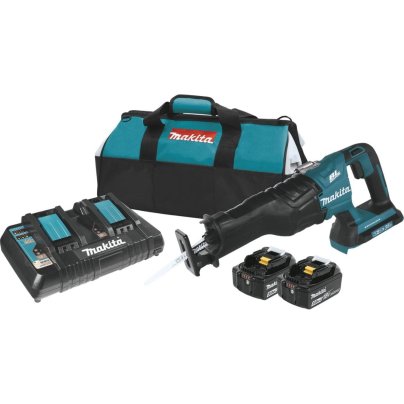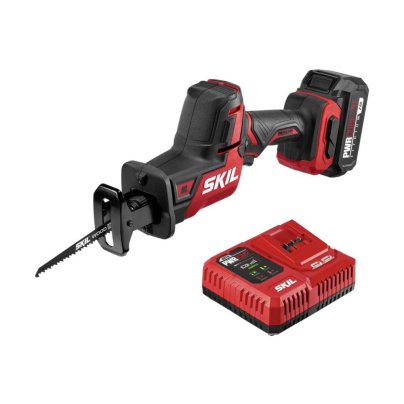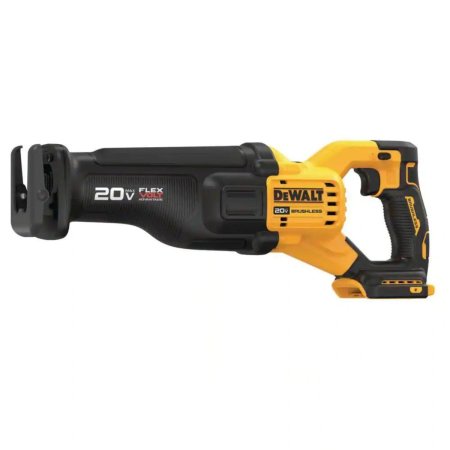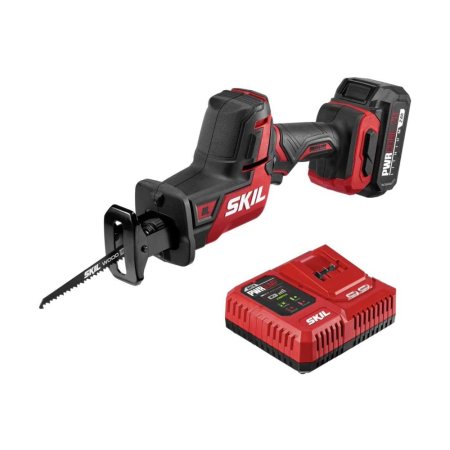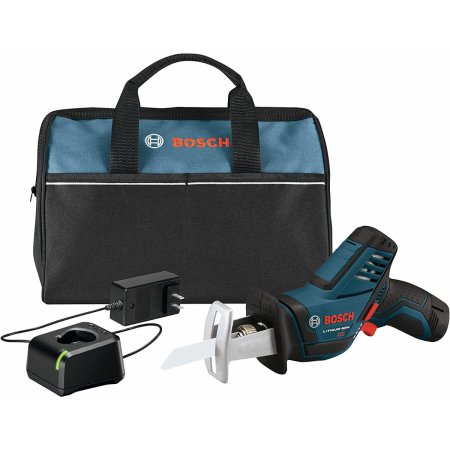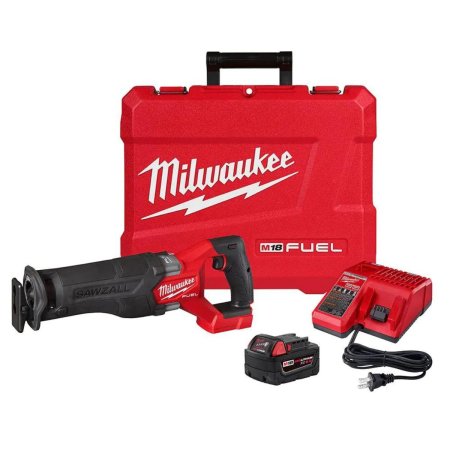
We may earn revenue from the products available on this page and participate in affiliate programs. Learn More ›
Reciprocating saws—power tools with long, thin blades that employ a back-and-forth motion to rip through material—have always been considered one of the most versatile saws around. And now, to increase their go-anywhere, cut-anything prowess, they’re available in battery-powered cordless models. There’s not much these saws can’t do when it comes to rough cutting.
In general, reciprocating saws are meant for demolition—tearing out walls, cutting away pipes, and severing nails and bolts from between floor plates. This saw is a top option for both contractors and DIYers who want to make quick, powerful cuts. Reciprocating saws have been popular since the Milwaukee Tool Company produced the first one of its kind—the legendary Sawzall—in 1951. Since then, many tool manufacturers have been making their own reciprocating saws, and with so many models available, we wanted to see which ones truly delivered on the promise of convenience and power.
We ordered the top reciprocating models on the market today and put them through their paces. We didn’t go easy on them—after all, a demolition tool needs to withstand a lot of use and abuse. We cut dimensional lumber, plywood, polyvinyl chloride (PVC), steel, and more. Our top spot went to DeWalt’s model thanks to its powerful battery and comfortable rubberized grip. Keep reading to learn more about choosing the best cordless reciprocating saw, and find out how the following models earned a spot on this lineup.
- BEST OVERALL: DeWalt 20V MAX Cordless Brushless Reciprocating Saw
Jump to Review - RUNNER-UP: Makita 36V LXT Brushless Cordless Recipro Saw Kit
Jump to Review - BEST BANG FOR THE BUCK: Skil PWR CORE 20 Brushless Compact Reciprocating Saw
Jump to Review - BEST ONE-HAND GRIP: Ryobi 18V One+ HP Brushless Reciprocating Saw
Jump to Review - BEST 12-VOLT: Bosch PS60-102 12V Max Pocket Reciprocating Saw Kit
Jump to Review - BEST JOBSITE PICK: Milwaukee M18 Fuel Sawzall Reciprocating Saw
Jump to Review - BEST SUBCOMPACT: Makita 18V LXT Sub-Compact Cordless Recipro Saw Kit
Jump to Review

Before You Buy a Cordless Reciprocating Saw
If there’s one area in which a cordless reciprocating saw does not excel, it’s precision. These saws have a lot of power, but the blades are long, relatively thin strips of metal that attach to the saw on just one end. As the saw pushes the blade back and forth, it will bow and bend, similar to a handsaw, but at greater speeds.
For this reason, it can be challenging to achieve consistent or square cuts on a stack of lumber. Users might be able to get each piece within ¼ inch of each other, but the discrepancy between pieces will likely make them unusable for building, and the cut end will rarely be square.
When straight, accurate cuts are crucial, go with a circular, miter, or table saw—all tools whose design allows them to make consistent, repeatable cuts at specific angles. But for all those other sawing jobs—especially demolition tasks—it’s tough to beat the power and versatility of a cordless reciprocating saw.
How We Tested the Best Cordless Reciprocating Saws
Putting together a list of the best cordless reciprocating saws to test was challenging work. We had to draw upon our contracting experience and DIY projects to pick out the features we felt were must-haves and those we could do without.
In the end, we selected reciprocating saws with a range of power from known manufacturers. DeWalt, Makita, and Milwaukee are top-of-the-line power-tool makers, so we had a good feeling about their products, and they didn’t let us down.
For the actual hands-on testing, we fitted each of the saws with blades designed to cut specific test materials. For example, before we cut metal pipes, we fitted the saws with metal blades. Before we cut tree limbs, we fitted the saws with arbor blades.
We noted how quickly the saw chewed through the material as we cut through plywood, dimensional lumber, steel pipes, PVC pipes, and limbs. We also noted how easy it was to operate the saw. We checked every function on each tool, including the blade-changing mechanisms and variable-speed trigger sensitivity (more sensitivity was better), and we scored each saw using a rubric.
The better a tool performed, the higher its score on that test. After testing was complete, we added and averaged all the scores and used them to help categorize the saws.
| Testing Stats | |
| Products tested | 7 |
| Time spent testing | 7 hours |
| Tests performed | 8 |
| Price range | $100 to $400 |
Our Top Picks
Adding the best cordless reciprocating saw to a tool chest might seem like a no-brainer, but choosing from among all the models on the market can be a challenge. While reciprocating saws don’t come with many bells and whistles, some are better suited to specific tasks than others. The results of our hands-on testing can help readers choose between the different models. Find out how each one of the following reciprocating saws performed in our testing, and learn the pros and cons of each model before investing in one of these tools.
Best Overall
DeWalt 20V MAX Cordless Brushless Reciprocating Saw
Product Specs
- Model: DCS386
- Cutting speed: 0 to 3,000 SPM
- Stroke length: 1⅛ inch
This Bob Vila Approved product carries our brand’s highest level of recommendation.

Bob Vila Approved recognizes the household and DIY products that impressed us most in our real-world testing and that exemplify core values of the Bob Vila brand, including craftsmanship, innovation, and value for the dollar. Winners of this designation come recommended by our professional review team and are personally approved by Bob Vila.
Our Ratings: Ease of Use 4/5; Performance 5/5; Build Quality 5/5; Value 5/5
What We Like
- Rubberized overmold grip allows users to get a firm grasp during use
- Comes with a powerful 6Ah battery; suitable for most tasks
- Brushless motor means less wear out of internal parts
What We Don’t Like
- A hefty 11.5 pounds with the battery installed
- Pricey compared to similar options
We’re familiar with the high quality of DeWalt power tools, but we were still impressed at the beefiness of the 20-volt (V) MAX reciprocating saw. This is a full-size saw—it weighs in at a hefty 11.5 pounds with the battery installed. The rubber overmold on the handle and barrel allowed us to get a firm grasp, which is crucial on such a powerful saw. Like most reciprocating saws, it’s wholly symmetrical and can be used just as easily by a left-hander as a right-hander. It boasts a brushless motor—which means less friction in the motor and fewer internal parts to wear out.
We tested this saw on plywood, dimensional boards, steel pipes, screws, and nails, and it cut through all of them with power to spare. We really liked its variable trigger. With just a light pull on the trigger, it started nice and slow (some variable-speed triggers start at too quick a pace), and we were able to increase the speed incrementally just by pulling harder. At top speed—3,000 strokes per minute (SPM)—the DeWalt is a monster of a saw. Users will need to keep a firm grip on this tool at high speeds.
The stroke length of 1⅛ inches was plenty long enough for sawing through boards and pipes, and the blade clamp on the front made it easy and quick to swap out the various blades we used for testing (metal, arbor, wood, steel). This powerful saw cut through all our test materials with ease.
This reciprocating saw uses the same 20V MAX batteries as other DeWalt 20V MAX power tools, so users can swap them back and forth if desired. The kit comes with a 6Ah FlexVolt battery and a battery charger. This top-performing reciprocating saw features a handy LED guide light that turned on automatically when we pulled the trigger.
Get the DeWalt cordless reciprocating saw at Ace Hardware (tool only, no battery), The Home Depot (tool only, no battery), or Acme Tools (tool only, no battery).
Runner-Up
Makita 36V LXT Brushless Cordless Recipro Saw Kit
Product Specs
- Model: XRJ06Z (tool only)
- Cutting speed: 0 to 3,000 SPM
- Stroke length: 1¼ inch
Our Ratings: Ease of Use 4/5; Performance 5/5; Build Quality 5/5; Value 5/5
What We Like
- Accommodates 2 lithium-ion batteries; ideal for extended use
- Longer blade stroke than most of its competition (1¼ inches)
- Brushless motor great at providing extended battery life
What We Don’t Like
- Fairly heavy; operating for long periods can be tiresome
Makita’s 36V reciprocating saw is worth checking out for anyone hunting for a long blade stroke and speed control. It offers speed adjustment via its two-speed selection switch. When we selected the lowest speed option, the saw topped out at 2,300 SPM. When we chose the high-speed option, the blade cut at a robust 3,000 SPM. However, on either setting, we could use light trigger pressure and bring the speed down, thanks to its sensitive variable-speed trigger.
In addition to holding two 18V lithium-ion batteries for extended run time, the Makita features a brushless motor for making the most of the batteries and for less wear on the motor. This is a heavy-duty tool—it weighs in at a beefy 10.2 pounds with batteries installed—but its rubberized grip and ergonomic design reduce fatigue.
This model also features a lengthy 1¼-inch blade stroke, which provides several more cutting teeth per stroke than shorter blades. It made quick work of cutting through our testing materials (plywood, dimensional lumber, steel, and PVC pipes).
As a bonus, it comes with a bright LED guide light and a fold-out rafter hook for hanging the saw over a rafter or joist while working. We really liked this feature because it allows the user to hang the saw safely when working at heights rather than setting it somewhere it could fall.
Get the Makita 36V cordless reciprocating saw at Amazon or The Home Depot (tool only).
Best Bang for the Buck
Skil PWR CORE 20 Brushless Compact Reciprocating Saw
Product Specs
- Model: RS5825B
- Cutting speed: 0 to 3,000 SPM
- Stroke length: 1 inch
Our Ratings: Ease of Use 4/5; Performance 3.5/5; Build Quality 4/5; Value 4/5
What We Like
- Affordable price point compared to similar models
- High top speed can cope with most cutting jobs
- Onboard LED work light helps with visibility in tight, dark spaces
What We Don’t Like
- Variable-speed trigger not sensitive enough
- Included battery had short runtime; not ideal for extended use
Those looking for an affordable option for projects around the house might be interested in the Skil. This kit comes with a compact saw (model RS5825B), a 2.0 Ah 20V lithium-ion battery, one wood blade, and a charger, allowing users to get to work straight away.
In testing, it proved to have enough power to complete moderate demolition tasks, including cutting through plywood, steel pipe, and even green tree limbs, when fitted with the corresponding blades. A compact model, it weighs about 7 pounds with the battery attached (the battery weighs in around 3 pounds), and we found it lightweight enough to use for overhead cutting without a lot of arm fatigue. We liked its bright LED guide light, which clearly illuminated the material being cut. Its variable trigger, unfortunately, wasn’t as sensitive as those on higher-priced models. We found it challenging to slow it down without stopping altogether, and it goes from 0 to 3,000 SPM with just slight pressure on the trigger.
The stroke length is 1 inch, which isn’t aggressive but is typically more than enough for DIY demolition projects. We found it comfortable to grip and easy to use, although we would suggest purchasing an additional battery with a higher Ah rating to extend runtime. The included 2Ah battery started to run down after 30 minutes of use.
Get the Skil cordless reciprocating saw at Amazon or Lowe’s.
Best One-Hand Grip
Ryobi 18V One+ HP Brushless Reciprocating Saw
Product Specs
- Model: PSBRS01K
- Cutting speed: 0 to 3,000 SPM
- Stroke length: ⅝ inch
Our Ratings: Ease of Use 4/5; Performance 4/5; Build Quality 5/5; Value 4/5
What We Like
- Tool feels balanced and is easy to run one-handed
- Good variable-speed trigger helps tackle a variety of tasks
- LED guide light is strong and clear
- Brushless motor helps with tool longevity
What We Don’t Like
- Rather short blade-stroke length; can struggle cutting dense green wood
- Battery not as powerful as some
For quick cutting of wood, plywood, and pipes where a free hand is necessary to grasp the material, we’re happy to recommend the Ryobi 18V, model PSBRS01K. This reciprocating saw, which has a brushless motor, weighs less than 6 pounds with the battery installed, and we found it easy to grip and maneuver with just one hand. This allowed us to steady the materials while we were testing to ensure smoother cuts.
We cut a variety of materials (using material-appropriate blades). The PSBRS01K did a fine job on all materials except green tree limbs. We’d inserted a new arbor blade, so that wasn’t the issue, but in testing it felt as though the dense green wood was bogging down the saw blade. We lightened up on the pressure and eventually cut through the limb, but it took about twice as long as the other saws did. This may have been partially due to its relatively short ⅝-inch blade stroke. However, the Ryobi saw comes with a mediocre 18V 1.5Ah lithium-ion battery—that’s less than a third of the power of the 6Ah battery our top pick provides. A more powerful battery might make a big difference.
The Ryobi reciprocating saw has some definite upsides, though. Its design and light weight didn’t cause arm and hand fatigue, and the variable-speed trigger was just as sensitive as the more expensive tools—it will still generate 3,000 SPM at top speed. Its guide light is also strong and clear. In the end, we liked this saw for the ability to use it with just one hand. It is suitable for light-duty demo uses, but its battery could stand to be more powerful.
Get the Ryobi cordless reciprocating saw at Amazon or The Home Depot.
Best 12-Volt
Bosch PS60-102 12V Max Pocket Reciprocating Saw Kit
Product Specs
- Model: PS60-102
- Cutting speed: 0 to 3,600 SPM
- Stroke length: ⅝ inch
Our Ratings: Ease of Use 4/5; Performance 4/5; Build Quality 3/5; Value 3.8/5
What We Like
- Quieter operation compared to similar models
- Compact and lightweight is easy to maneuver and prevents hand fatigue
- Battery-life indicator allows users a quick glance at the power level
What We Don’t Like
- Motor is not brushless; may wear out sooner than other options
- Guide light is on the dim side compared to similar tools
After testing some of the full-size reciprocating saws in this lineup, the Bosch PS60-102 reciprocating saw seemed quite small in comparison. It’s a 12V rather than an 18V or 20V model and has a relatively short ⅝-inch stroke length. We weren’t expecting a burst of power from this little tool, but we were pleasantly surprised.
During our tests using the different blades, it took slightly longer to saw through the materials with the PS60-102 than with the more powerful saws, but it didn’t bog down when cutting. It’s a light-duty saw for sure, but it’s robust and capable of making multiple cuts for demolition purposes. Its variable-speed trigger is sensitive and easy to regulate using finger pressure.
Our favorite use for this saw, however, was for tree pruning. We fitted it with an arbor saw, and it made quick work of cutting away both green and dead wood. We found its LED light to be a bit on the wimpy side for use in dim lighting situations but appreciated the battery-indicator light right by the trigger. The others we tested had indicator lights on the batteries themselves, which is standard, but checking those requires turning the tool upside down. With the PS60-102, we could easily see the battery life as we cut. It’s also quite a bit quieter than the bigger models, which is to be expected due to the smaller battery, but it’s still a nice plus.
Get the Bosch cordless reciprocating saw at Amazon, Tractor Supply Co., or Parts Warehouse.
Best Jobsite Pick
Milwaukee M18 Fuel Sawzall Reciprocating Saw
Product Specs
- Model: 2821-21
- Cutting speed: 0 to 3,000 SPM
- Stroke length: 1¼ inch
Our Ratings: Ease of Use 5/5; Performance 4/5; Build Quality 3.5/5; Value 4/5
What We Like
- Rubber overmold and comfortable design helps with extended use
- Powerful LED light great at illuminating the work area
- Long 1¼-inch stroke length handles a variety of thicknesses
- Rafter hook for hanging while working is a convenient bonus
What We Don’t Like
- Battery-indicator light didn’t work
Having owned—and loved—one of the original reciprocating saws (the Sawzall) made by Milwaukee, we had to test this upgraded cordless version. Milwaukee is known for its quality pro tools, and this high-end model, the 2821-21, is no exception. Its rugged, robust design is well suited to large demolition projects.
It has a brushless motor for battery enhancement and longer motor life, and it comes with a powerful 18V 5Ah battery. It’s relatively heavy at just under 10 pounds with the battery installed. Still, it offers a rubber overmold and ergonomic styling that allowed us to get a firm grip when operating the saw.
It features a long 1¼ -inch stroke length, and when fitted with the appropriate blades, it quickly chewed through all the materials we put in its path, including plywood, dimensional lumber, steel and PVC pipes, and tree limbs. The variable-speed trigger is highly sensitive, and we used it at a very slow speed as well as its maximum 3,000 SPM.
The LED light on this saw is excellent, and we were able to turn off the shop lights and cut in dim lighting with only the guide light—it’s that bright. A spring lever on the side makes blade change a snap, and the 2821-21 comes with a steel rafter hook for conveniently hanging the tool when working at heights. The only complaint we had was that the light on the battery indicator didn’t work, but that may have been a problem with this particular tested tool. The Milwaukee Sawzall may well do everything a DIYer needs and be well suited for professional demolition use as well.
Get the Milwaukee cordless reciprocating saw at Ace Hardware, The Home Depot, or Blain’s Farm & Fleet.
Best Subcompact
Makita 18V LXT Sub-Compact Cordless Recipro Saw Kit
Product Specs
- Model: XRJ07R1B
- Cutting speed: 0 to 3,000 SPM
- Stroke length: 13/16 inch
Our Ratings: Ease of Use 4/5; Performance 5/5; Build Quality 5/5; Value 4/5
What We Like
- Compact design with plenty of power for tackling most projects
- Lightweight at just 5.7 pounds with the battery attached
- Rubberized handle offers users plenty of grip and comfort
What We Don’t Like
- Not suitable for one-handed use; no free hands to keep the material steady
There’s compact, and then there’s subcompact, the latter describing Makita’s XRJ07R1B 18V LXT cordless reciprocating saw. This saw’s focus is punching above its weight class, offering 3,000 SPM while measuring just 12½ inches long and weighing only 5.7 pounds with the battery attached. While it’s lightweight, we found it to be a two-handed saw rather than a one-handed saw due to its design. We tried using it with one hand, but it’s not balanced well enough—we had to use a second hand along the lower front edge for support.
As compact as this saw is, it does vibrate quite a bit—more like a full-size model than a compact one—but that also speaks to its power. This robust little saw cut right through all our test materials: wood, plywood, steel pipes, PVC pipes, and tree limbs. It didn’t let up for anything, unless we purposely slowed it down via its sensitive variable-speed trigger.
The saw features a brushless motor that offers more power and battery efficiency than brushed alternatives. This unit has a stroke length of 13/16 inch, which is on the slightly short side, but it’s made for cutting in tight spots where a longer stroke length might not work.
The rubberized overmold makes it easy to grip the tool firmly without slipping, and the LED guide light is bright and clear. It comes with an 18V 2Ah rechargeable lithium-ion battery. This is a powerful saw, but we admit we weren’t thrilled with its boxy design. We’d love to see Makita redesign this model for one-handed use while keeping all its other perks.
Get the Makita 18V cordless reciprocating saw at Amazon, The Home Depot, or Tractor Supply Co.
Jump to Our Top Picks
What to Consider When Choosing a Cordless Reciprocating Saw
A cordless reciprocating saw can be an indispensable tool, as it can cut materials in a few seconds that would otherwise take several minutes to get through with a handsaw—or not be possible to cut at all. But there are a few factors to consider when shopping for these tools, which are explained in detail below.
Standard vs. Compact/One-Handed
When cordless reciprocating saws first appeared, they only came in large, dual-handed versions. Since then, manufacturers have realized there’s a market for compact or one-handed models.
- Standard cordless reciprocating saws feature two-handed designs with lots of power. They’re often almost 2 feet long and can weigh 10 pounds or more. Although they can be a bit of a handful, they provide excellent cutting control.
- Compact and one-handed designs, as the names suggest, are smaller and easier to manipulate. They can be ideal for light-duty jobs since they often weigh less than 6 pounds. Some compact models can produce nearly as much power as standard models, but they still require two hands for maximum control. One-handed models aren’t as powerful, but users can easily manipulate them with just one hand, which leaves the other hand free to hold and stabilize the material being cut.

Power & Variable Speed
Some of the earliest corded reciprocating saws had two modes—on or off—with no method of speed control. A single speed makes it harder to control the cut and wears blades out faster. Luckily, many of today’s cordless models benefit from adjustable speeds.
Good cordless reciprocating saws have variable-speed triggers that allow the user to throttle the speed of the saw blade from just a few strokes per minute to full speed, which might be more than 2,500 strokes per minute. This variable speed allows the user to start the blade as accurately as possible and get the most life out of a blade or battery. And because full-size reciprocating saws are pretty powerful, being able to start the blade at a slow speed and then increase the speed when necessary offers a measure of safety.
Orbital Action
Most reciprocating saws use a back-and-forth stroke to gnaw through a material. The backward stroke cuts through the material, while the forward stroke resets the blade. This is usually more than sufficient, but when it comes to cutting through softer materials such as construction lumber, there’s another way: orbital action.
Reciprocating saws with orbital action (slight elliptical motion) use a more circular blade path while cutting. On the blade’s backstroke, the saw blade also travels downward. On the forward stroke, the blade travels upward. This oval motion allows the blade to cut faster through softer materials like pine, cedar, and redwood, but it can’t do much besides make a chattering racket when it comes to cutting harder material like metal. Orbital action can be a feature on a cordless reciprocating saw but is not common, and none of the saws we tested came with orbital action.
Blade Type and Stroke
All reciprocating saws (corded or cordless) use interchangeable blades; each type has a purpose for which it’s most suitable. Choosing the right blade allows the saw to cut most efficiently.
- Wood blades have large, aggressive teeth that rip through wood very quickly. They’re excellent for cutting through wood that’s free from nails or even for yard cleanup.
- Metal blades have small, fine teeth that remove small chunks of metal with each stroke. They’re best for cutting metal pipes, angle iron, and similar materials.
- Demolition/construction/combination blades can cut a mix of wood and metal. These blades’ primary purpose is to cut through wood and slice through any embedded nails they might come across in the process.
- Arbor blades are also called pruning blades. These blades are designed to cut dead or green tree and shrub branches, making them useful for the DIY arborist who needs to prune trees and bushes.
It’s also worth noting that reciprocating saws have different stroke lengths. This refers to the back-and-forth distance that the blade travels. Compact models might have strokes under an inch, while larger models may exceed 1⅛ inches. The longer the stroke, the more teeth will pass over the material with each pass, which speeds up cutting. But saws with longer strokes can be challenging to use in restricted locations where the end of the saw can bump into a wall or other item that’s right behind the material being cut.
We interviewed Jacob Rhodes, the Owner and Chief Engineer at TrueTrac, a family-owned and operated specialty woodworking tool manufacturing company in southern Ohio. He recommends different stroke lengths depending on what you plan on using the reciprocating saw for: “Opt for a saw with a longer stroke length (over 1.5 inches) for deeper cuts in thicker and heavier duty materials.” He added that “if you’re only using it for delicate cuts and materials like wood and pvc, a stroke length of 1 inch to 1.5 inches is fine.”
Comfort
In recent years, manufacturers have started designing both corded and cordless tools, including reciprocating saws, with an eye toward ergonomics. While the original models work pretty well, there are days when a pro or DIYer might spend several hours using a reciprocating saw, and traditional grips and designs can result in hand and arm fatigue.
Some ergonomic models have specially designed handles that allow the user to hold the saw at different positions depending on the angle at which they’re sawing. This adjustable handle enables them to operate the tool in a more comfortable way.
Also, vibration control via rubber grips is becoming more popular in these saws. The rubber absorbs some of the vibration associated with high-speed sawing. This also lessens the fatigue on the user’s hands, arms, shoulders, back, and neck.
Battery Life
There are no hard-and-fast rules about battery life when it comes to reciprocating saws. But know that the larger the amp-hour rating (Ah) of the battery, the longer it will work for a particular saw. How long a battery will run, however, depends on too many factors to nail down, including:
- Sawing speed
- Material
- Blade used
- Battery Ah rating
Rhodes shared some expert advice on this matter, stating that shoppers should “Look for a voltage of at least 18V for tougher cuts and longer life between charges.” He also suggested making sure the batteries are lithium-Ion, “they are the industry standard, offering good lifespan and reliable performance.”
Cordless reciprocating saws with brushless motors will get more life out of a battery than the same model with a brushed motor. Motors with brushes—the old standard—tend to be slightly less powerful than brushless motors. The brushes create friction (resistance) in the motor, which requires the saw to use more battery power, resulting in shorter battery life.
Brushed motor tools are typically less expensive, but a brushless model is definitely the way to go if battery life is a priority. Remember to buy additional batteries for every model. Some saws are listed as a “bare tool” or “tool only,” which do not include batteries or battery chargers. Batteries are pricey, so some users purchase power tools of the same brand and then swap out batteries between them.
Shopping for a Used or Refurbished Reciprocating Saw
There is always the secondary market for folks who don’t want to invest a ton of money into a tool they might not use that often. The used marketplace is usually full of tools that DIYers purchased and have since moved on from. Users can score some of the best reciprocating saws at serious discounts.
Shoppers can check sites like Amazon Renewed, eBay Refurbished, and Walmart Restored for reciprocating saws. These sites often carry the most popular power tools and sell them for significantly less than a shopper might pay for a new version.
If purchasing directly from a private seller off of a classified site, there are a few things to consider:
- Check that the saw actually runs by snapping the battery in and pulling the trigger (in a safe manner, of course). Listen for any strange noises or clunking.
- Check that the blade chuck works correctly.
- Shake the tool and listen for any rattling inside the saw.
- Plan on replacing the battery relatively soon (so don’t pay top dollar).
FAQs
Even with this extensive background on the best cordless reciprocating saws, you might still want a bit more information. Below, find succinct answers to some of the most frequently asked questions about cordless reciprocating saws.
There are a lot of excellent uses for a reciprocating saw, and some examples include:
– Construction and demolition
– Cutting metal pipes
– Breaking down shipping pallets
– Yard work (such as pruning branches)
Reciprocating saws are not designed with any safeties or guards to keep them from cutting someone, so they can be very dangerous if used in an unsafe manner.
Some reciprocating saw blades have specific uses. Wood and metal blades are for cutting their respective materials, but construction or demolition blades offer a combination of both.
Yes, a cordless reciprocating saw fitted with a wood blade is an excellent tool for cutting tree branches. Arbor blades are also available, which make the task even easier.
To use a reciprocating saw:
1. Don your safety gear (gloves, safety glasses, and eye protection).
2. Unplug the tool if it’s a corded model or remove the battery if it’s a cordless model before opening the blade clamp and inserting the appropriate blade. 3. Close the blade clamp.
4. Connect a battery or plug the tool into an outlet.
5. Assuming a stable position, put one hand on the foregrip and one on the handle (for one-handed models, this might not be possible).
6. Position the blade above the material you’re preparing to cut.
7. Slowly squeeze the trigger to start the blade and then carefully lower the blade to start cutting.
8. Slowly increase the speed.
9. Release the trigger after cutting through the material.
Corded reciprocating saws have been known to last for many years, but even professionals can get several years out of cordless reciprocating saws. In general, the batteries will likely go bad first. Lithium-ion batteries only hold full charges for 3 to 5 years.
Meet the Tester
Glenda Taylor is a product tester and writer specializing in the construction, remodeling, and real estate industries. She and her husband own a general contracting company, and Taylor is experienced in both residential and commercial building applications. She tests a wide range of power tools as well as other home improvement, household, and lawn-and-garden products.

